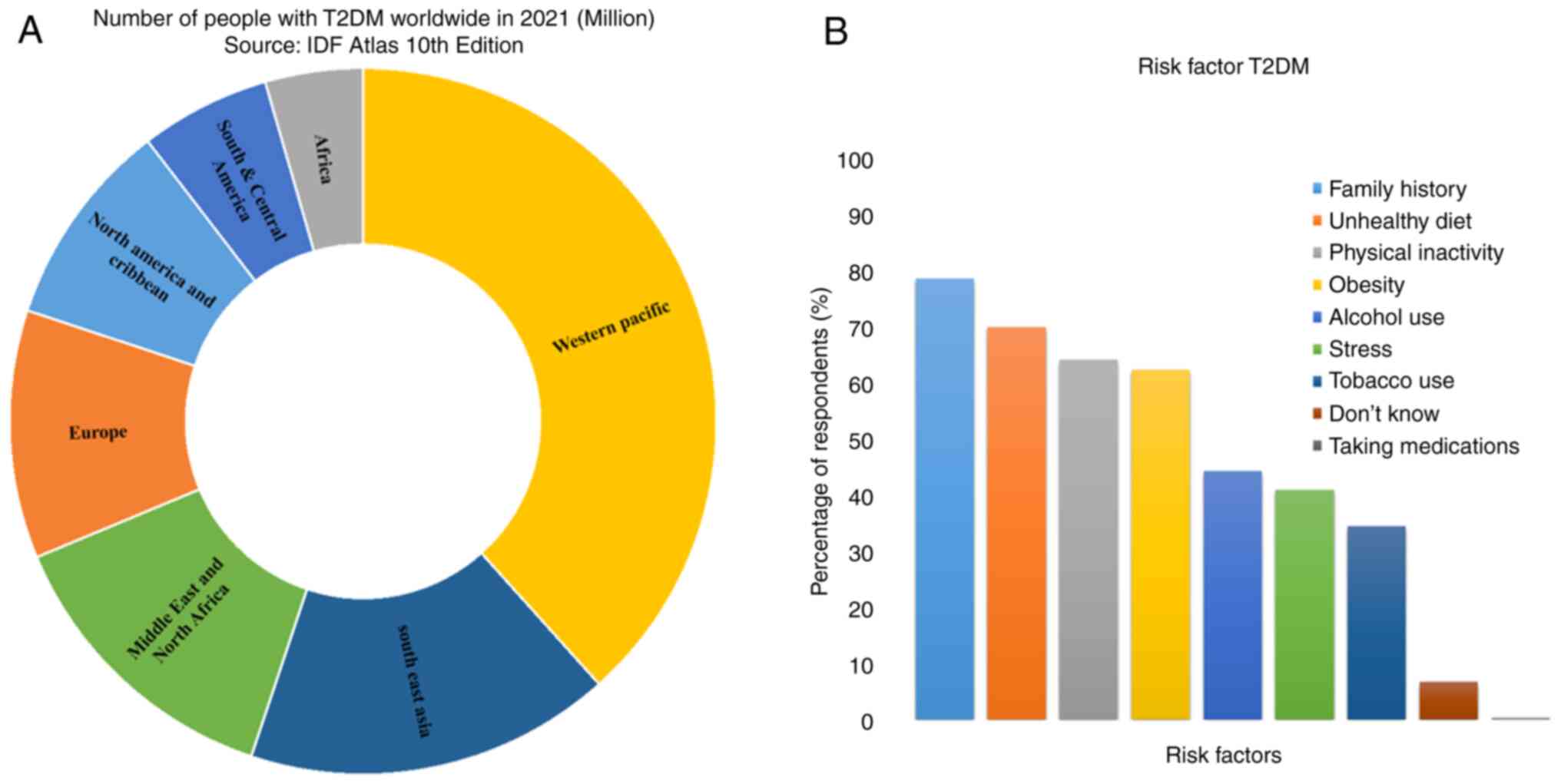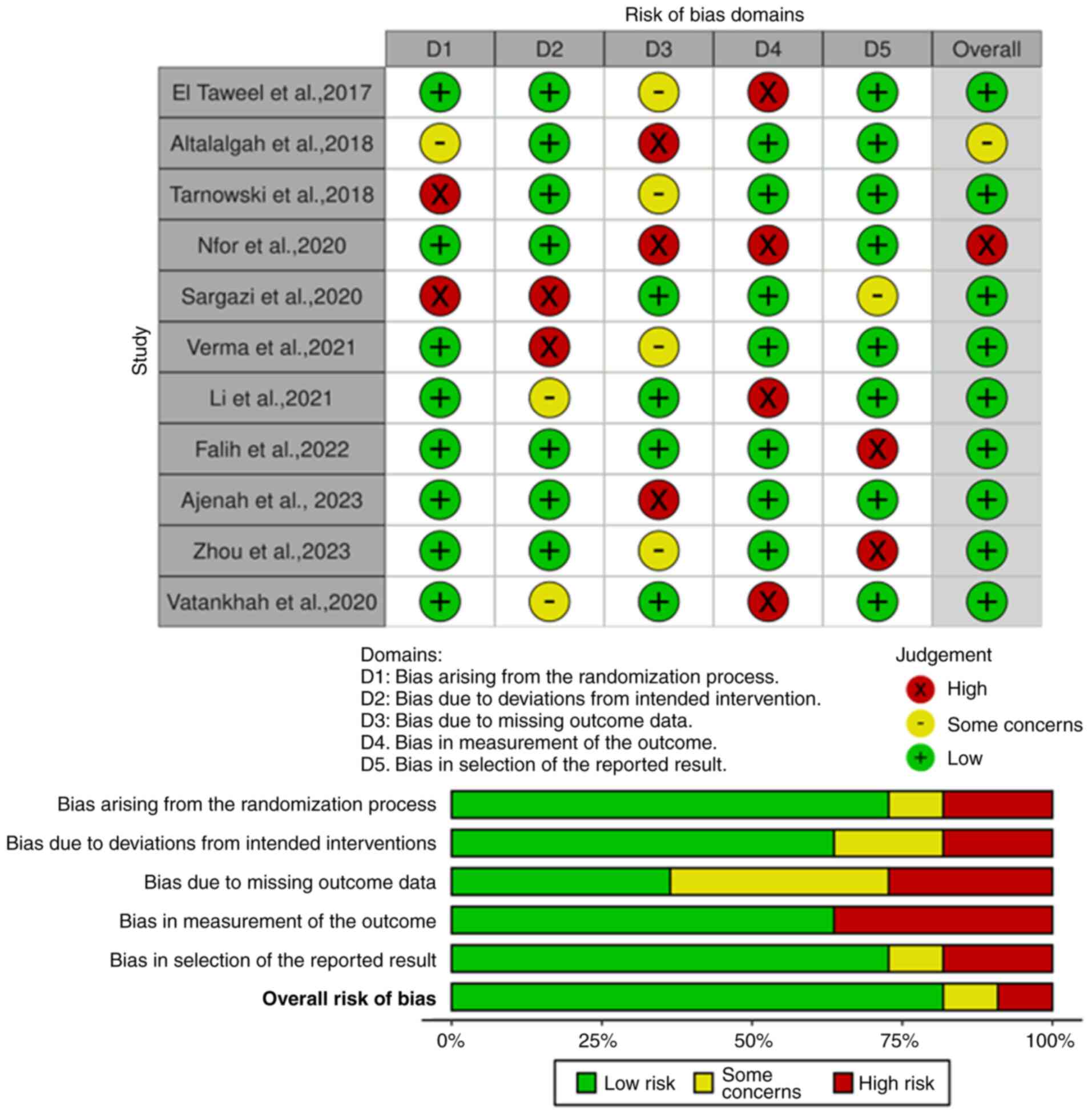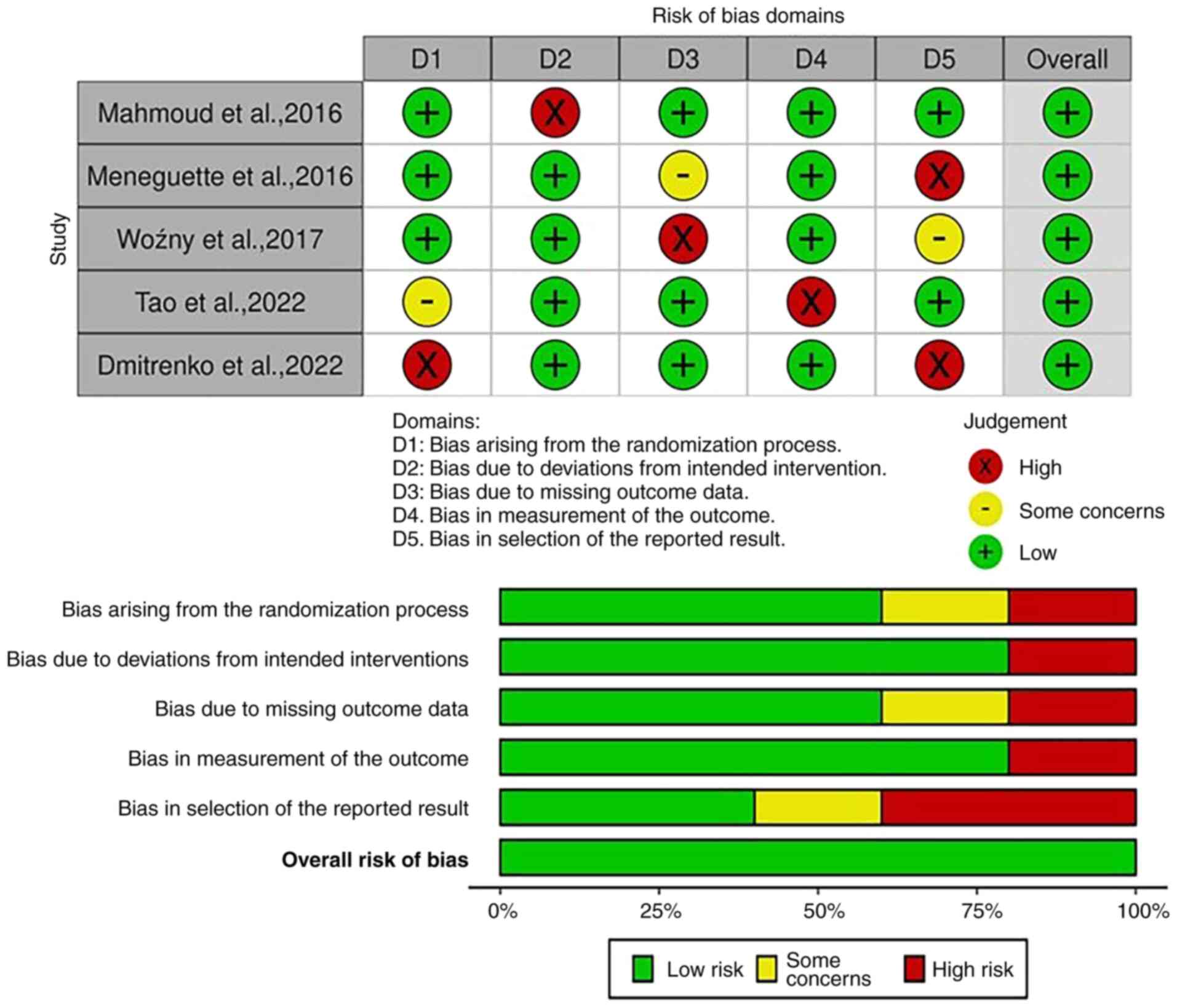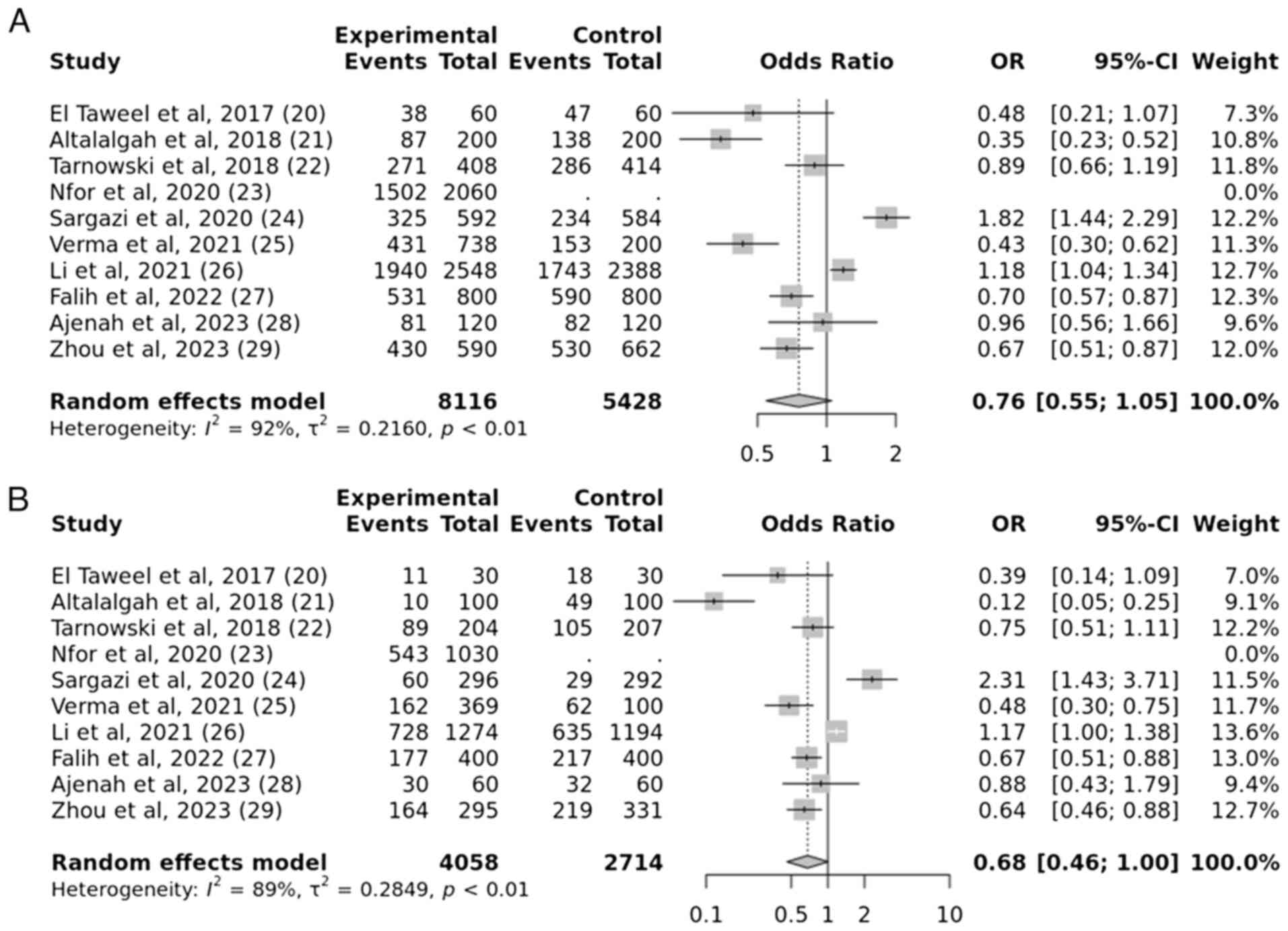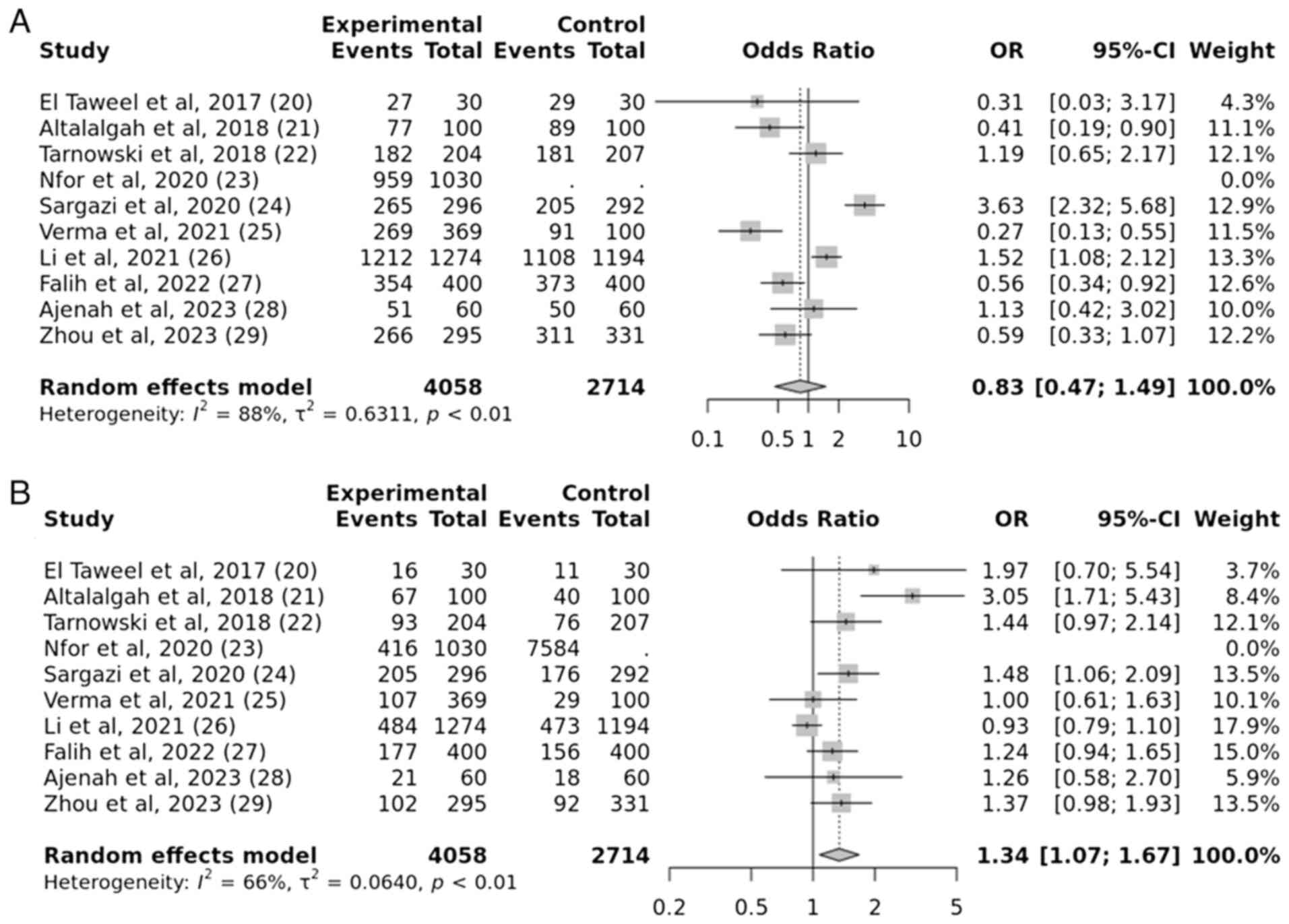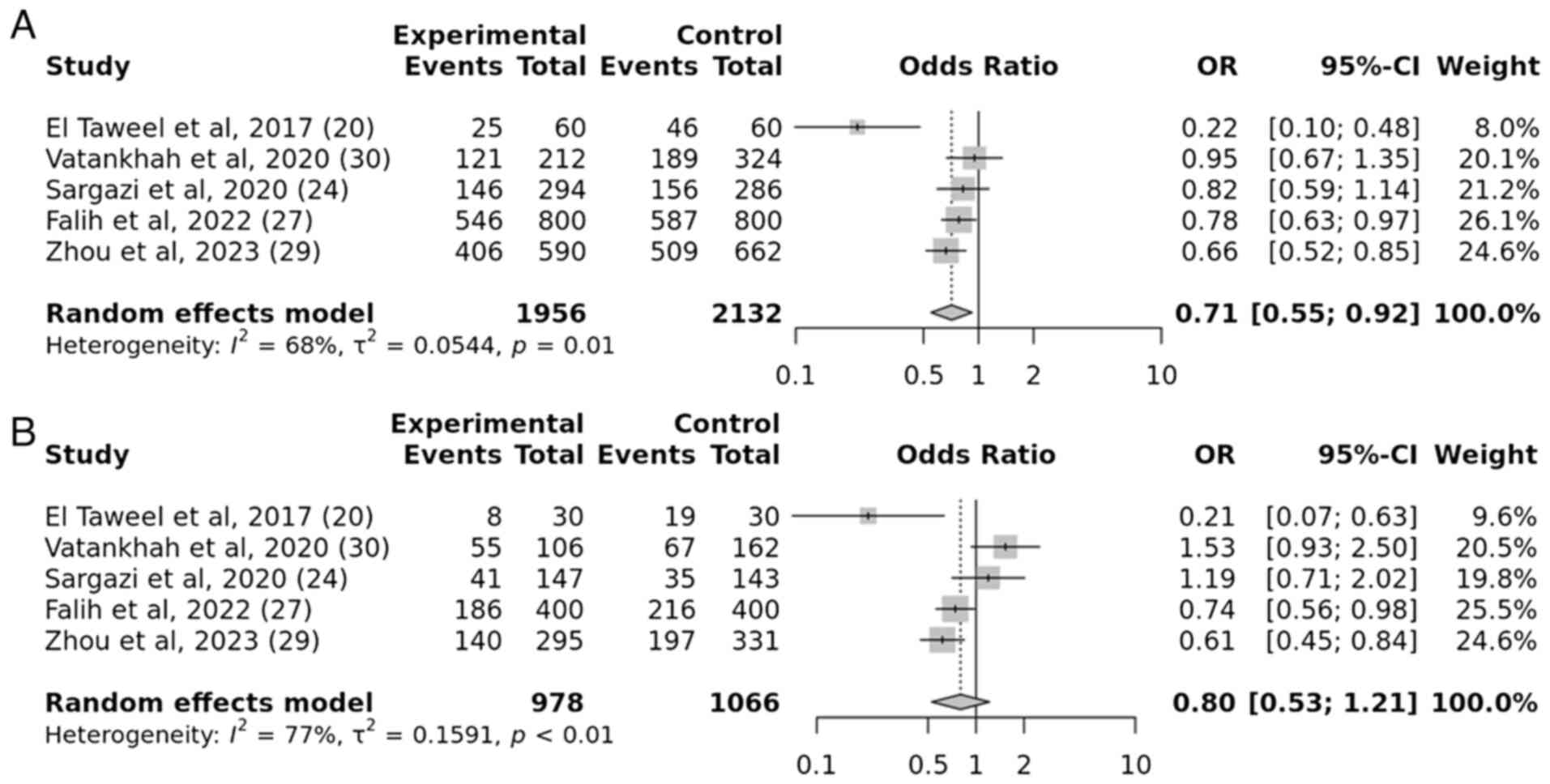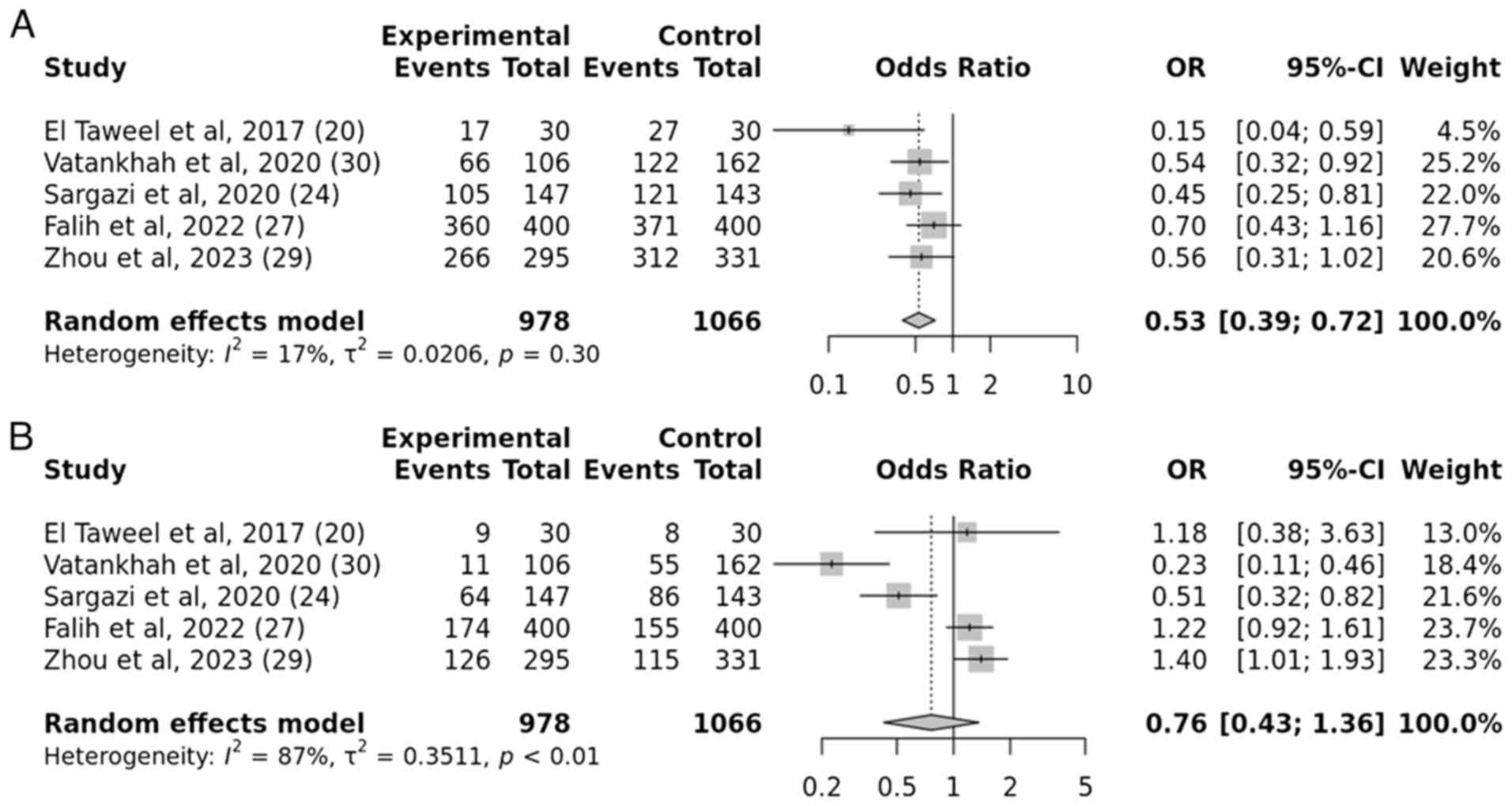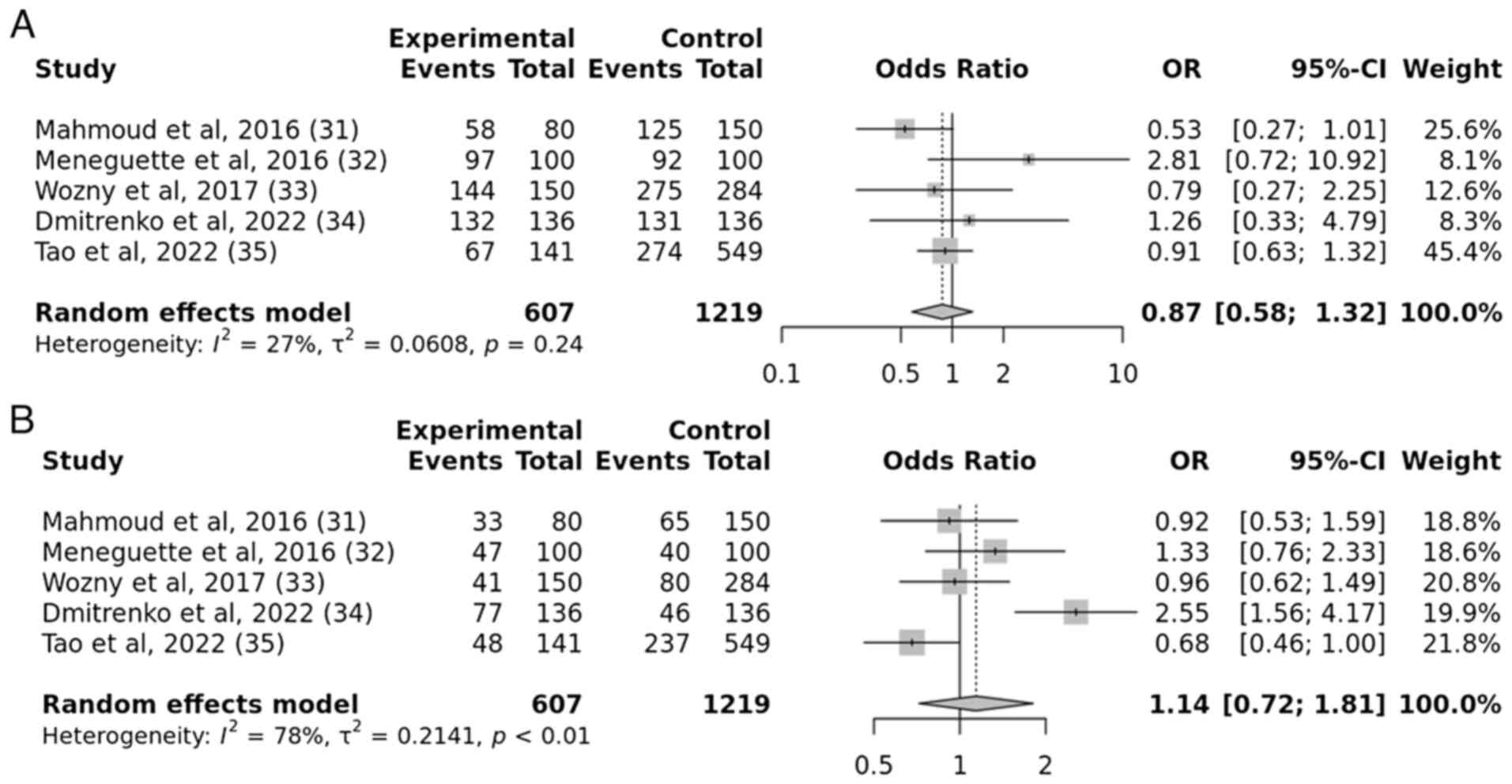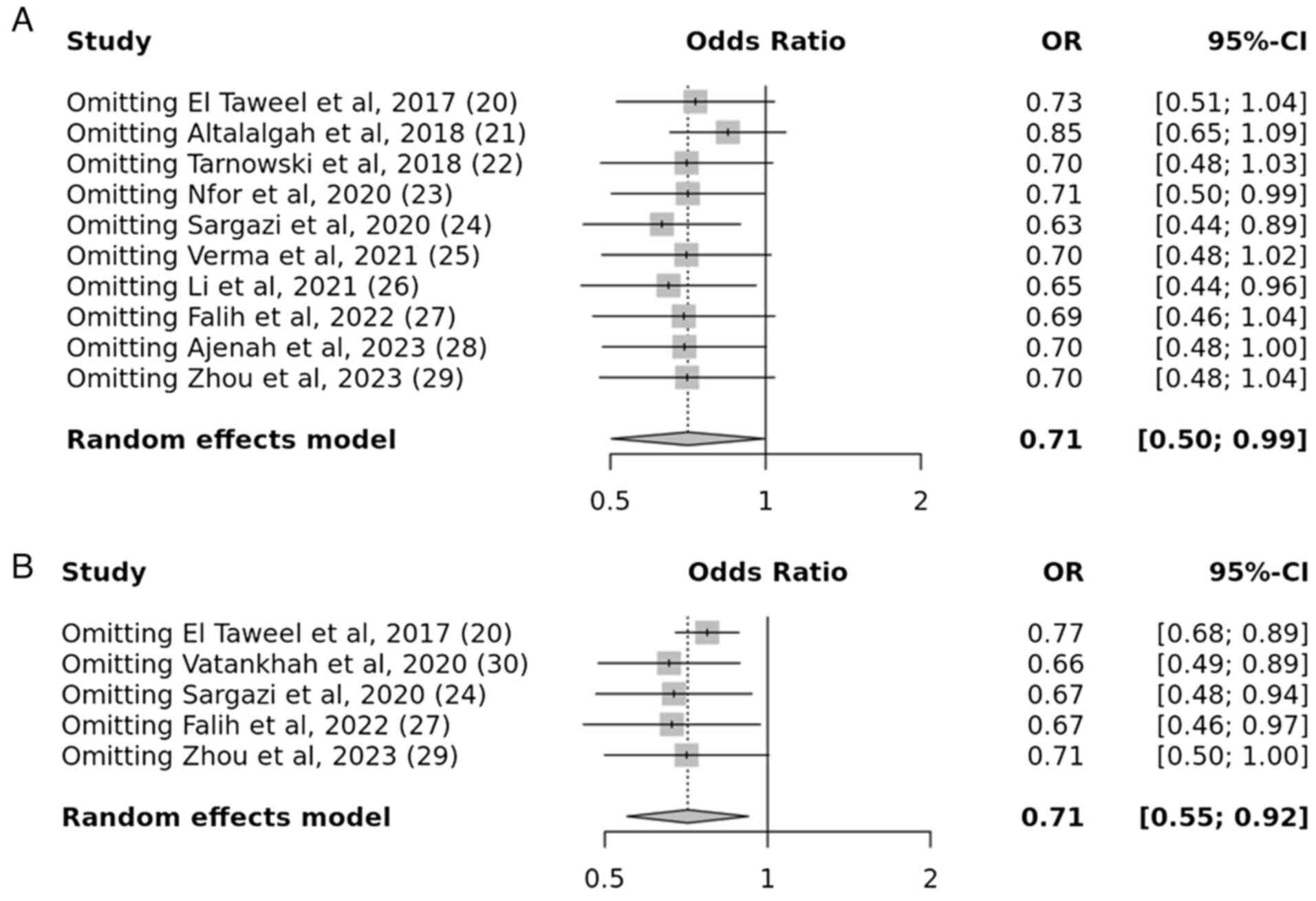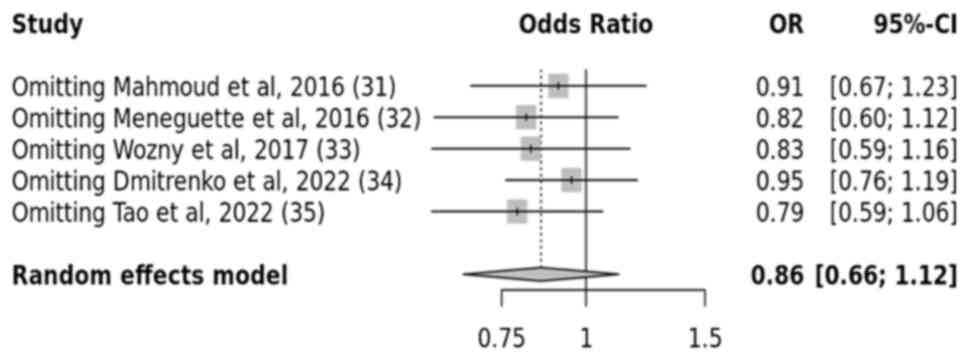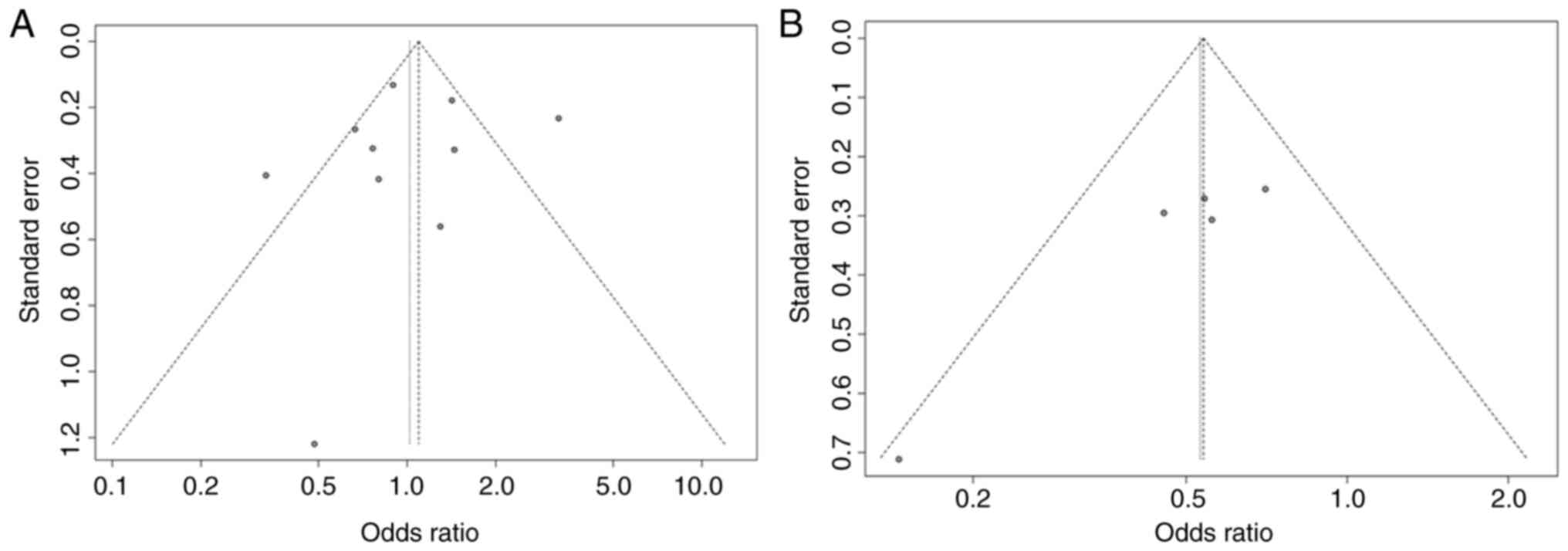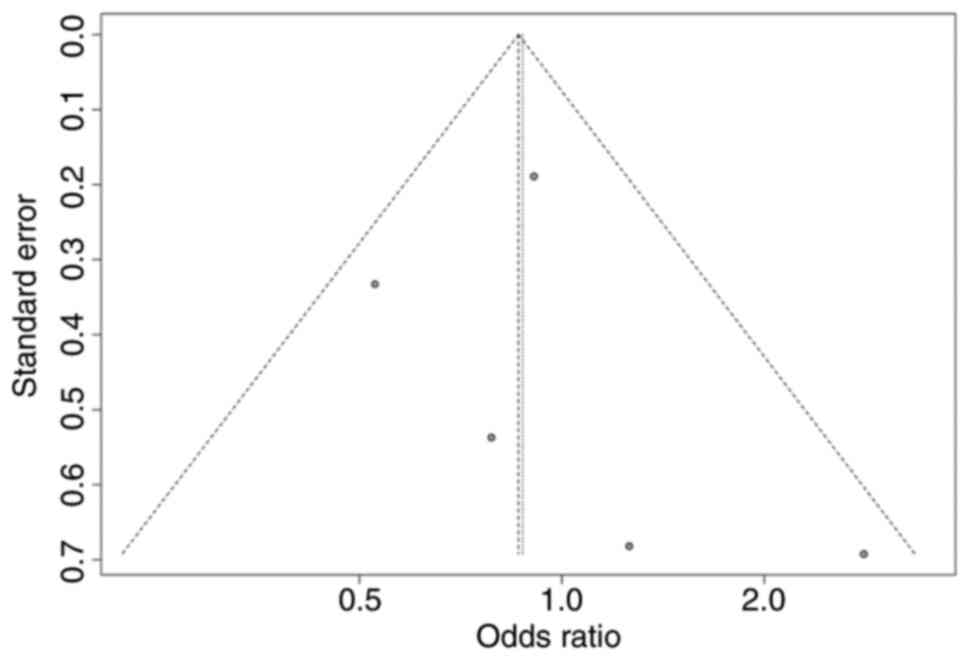Polymorphisms of IGF2BP2 and SIRT1 genes in type 2 diabetes mellitus: A comprehensive meta‑analysis and statistical power analysis
- Authors:
- Published online on: November 6, 2024 https://doi.org/10.3892/wasj.2024.292
- Article Number: 4
-
Copyright : © Velmurugan et al. This is an open access article distributed under the terms of Creative Commons Attribution License [CC BY 4.0].
Abstract
Introduction
Type 2 diabetes mellitus (T2DM) poses a significant public health concern that has an impact on the quality of life of affected individuals, thereby creating a financial burden on society (1). Based on the World Health Organization (WHO) data (2019), non-communicable diseases are responsible for 74% of global deaths. Specifically, diabetes was ranked as the tenth leading cause of mortality worldwide in 2019, with fatalities accounting for 1.6 million. It is estimated that by 2035, ~592 million individuals could lose their lives due to diabetes-related complications (2). T2DM, which comprises 90% of all diabetes cases, used to be considered as a disease common in wealthy, developed countries. However, it has currently spread worldwide and is the leading cause of mortality and disability, particularly in younger individuals (3). The susceptibility to type 2 diabetes differs significantly worldwide, notably with Asian Indians, Native Americans and Pacific Islanders facing a notably elevated susceptibility to the condition. Since the 1990s, there has been a consistent increase in the worldwide occurrence of type 2 diabetes. In particular, there has been a substantial increase in the global diabetic population since the beginning of 2000(4). According to the International Diabetes Federation (IDF), 8.8% of adults globally have diabetes, with males being slightly more affected (9.6%) than females (9.0%). Presently, 463 million individuals have diabetes, and 374 million have impaired glucose tolerance (IGT), which is a precursor of the condition. Projections indicate these numbers could reach 700 million for diabetes and 548 million for IGT by the year 2045, a 51% increase from 2019(5). The global prevalence and risk factors for T2DM are presented in Fig. 1 (6,7).
T2DM is a long-term endocrine disorder marked by ‘hyperglycemia’, or the failure of the body to control blood sugar levels due to insulin resistance and a decreased insulin output. It is the most prevalent type of diabetes, affecting millions of individuals globally (8). T2DM is defined as a reduction in the responsiveness of the cells in the body to insulin, a hormone produced by the pancreas that manages blood sugar levels. To combat the resistance, the body generates more insulin; however, over time, the pancreas becomes less able to produce adequate insulin, which raises blood sugar levels (9). A variety of factors contribute to the onset of T2DM, including family background, age, socioeconomic status, ethnicity, weight issues, metabolic syndrome and specific unhealthy habits. The interaction among these risk factors in causing T2DM is a complex physiological process involving intricate genetic and environmental influences, which appear to differ across various population groups (10). Several indicators of T2DM include an increased thirst, reduced appetite, frequent urination and unexplained weight reduction. The failure to address T2DM could lead to complications, such as ulcers, heart-related issues, and harm to multiple organs such as the kidneys and nerves, as well as vision and hearing impairments (11). In addition to frequently occurring alongside other conditions, such as dyslipidemia and hypertension, T2DM poses a substantial standalone risk for developing coronary artery disease (CAD). Patients with T2DM experience elevated rates of cardiovascular disease, particularly CAD, which is associated with increased morbidity and mortality rates. While individuals without diabetes have a 25% chance of developing CAD, those with T2DM are at a 2-4-fold greater risk (12). Several research studies have established a connection between mutations in specific genes and the development of diabetes mellitus, particularly T2DM. These genes, in combination with environmental factors, contribute to the onset of T2DM through diverse pathways. The hereditary component of risk factors typically involves multiple genes interacting with each other or with environmental elements. Consequently, addressing genetic risk factors for T2DM could enhance the comprehension of these conditions and lead to improved clinical care.
Insulin-like growth factor (IGG) mRNA-2 binding protein 2 (IGF2BP2), a protein found on chromosome 3q27, plays roles in both embryonic development and the formation of the pancreas. Additionally, it governs the transcription of IGF2, a pivotal factor in the development of insulin action (13). IGF2BP2 has the potential to reduce the expression of IGF2 in both adipose tissue and the dysfunction of β-cells. This action affects a growth factor essential for regulating pancreatic development and fat cell formation. Moreover, IGF2BP2 is involved in T2DM, a condition linked to reduced insulin secretion (14). Research has demonstrated a significant association between IGF2BP2 and overweight or obesity, which are known risk factors for T2DM. Given the link between obesity and T2DM, it is hypothesized that the association between IGF2BP2 and T2DM may be influenced by obesity (15). This phenomenon is referred to as the interaction between IGF2BP2 and obesity in relation to T2DM. Moreover, IGF2BP2 is associated with decreased insulin secretion and significantly contributes to the development of T2DM across various ethnic populations.
Conversely, the sirtuin1 (SIRT1) gene, situated on chromosome 10, operates the nicotinamide adenine dinucleotide (NAD+)-dependent histone deacetylase (16). It falls under the category of enzymes known as silent information regulators, contributing to ageing, longevity and the development of age-related metabolic conditions, such as T2DM (17). The protein regulates pancreatic growth by controlling pancreatic and duodenal homeobox 1 transcription, modulates hepatic metabolism and gluconeogenesis by reducing G6Pase and phosphoenolpyruvate carboxykinase transcription, and inhibits adipogenesis by binding to genes regulated by peroxisome proliferator-activated receptor-γ. Notably, SIRT1 enhances insulin secretion by downregulating uncoupling protein (Ucp2) expression in pancreatic β-cell mitochondria (18). Numerous studies have demonstrated that SIRT1 plays a crucial role in glucose-dependent insulin secretion, gluconeogenesis, regulating inflammation, lipolysis, and β-cell survival. Its association with various histones and nonhistone substrates has a significant impact on the development and advancement of diabetes, particularly T2DM (19). However, additional validation is necessary to establish definitive findings. Hence, in the present study, a meta-analysis and statistical power assessment were conducted to explore the association between gene polymorphisms of IGF2BP2 and SIRT1 and their impact on susceptibility to T2DM.
Materials and methods
The Preferred Reporting Item for Systematic Review and Meta-Analysis (PRISMA) checklist was followed throughout the investigation, using the widely accepted guidelines for systematic reviews and meta-analyses. Furthermore, the International Prospective Register of Systematic Reviews (PROSPERO) validated the credibility of the study by confirming the registration of its prospective review protocol (ID: CRD42024545234).
Inclusion criteria
In the present meta-analysis, the following criteria were consistently applied to evaluate all the research articles. These criteria include: i) The study design must be a case-control with allelic and genotype frequencies; ii) the research must involve exploring genetic variations in the IGF2BP2 and SIRT1 genes that are linked to T2DM; and iii) only studies involving human subjects were considered.
Exclusion criteria
The studies that did not meet the following criteria were excluded: i) Studies are not related to IGF2BP2 and SIRT1 genetic variants associated with susceptibility to T2DM; ii) studies involving animal models; iii) studies lacking information on allelic and genotype frequency; and iv) non-clinical studies, abstracts and reviews were excluded.
Data extraction
The authors employed standardized criteria to gather relevant articles. Upon encountering any discrepancies, they discussed these with co-authors. Following this, the authors rigorously examined the retrieved articles to establish the genotype and allelic frequencies of both the case and control subjects. In instances where certain studies lacked complete genotypic data, missing values were estimated using available allelic frequencies. Studies where crucial data could not be extracted from the control and case groups were excluded. Each study provided the following information: Study design, sample size, first author name, ethnicity, publication year and Hardy-Weinberg equilibrium (HWE) score. Rigorous criteria were followed to meet the eligibility criteria and screen the data comprehensively.
Quality of studies using risk bias
A comprehensive evaluation of risk bias is crucial for accurately evaluating the methodological quality and potential biases of studies incorporated into a meta-analysis. In the present study, the Cochrane risk of bias tool (ROB2) software was utilized to assess the risk of bias in the research. The studies were classified into three groups based on their bias levels: ‘high risk’, ‘moderate risk’, and ‘low risk’.
Statistical analysis
The present study used a range of statistical methods to examine the genetic variations in the IGF2BP2 and SIRT1 gene polymorphisms and their impact on the development of T2DM. The odds ratios (ORs) with 95% confidence intervals (CIs) were calculated to evaluate the associations. The statistical significance was determined with a threshold set at P<0.05. The consistency of results across different studies was evaluated using the index of inconsistency, which measures the proportion of total variability across studies that is due to heterogeneity (I²) rather than random chance. A random-effects model was applied for all meta-analyses, regardless of the I² value observed, to account for potential variations among studies from different groups and geographical locations. Summary ORs were assessed using a Z-test (P<0.05), with heterogeneity among studies determined by the Q statistic and I2 value. In addition, a sensitivity analysis was performed to evaluate the effects of excluding specific studies, particularly those in which the controls did not conform to the HWE. Funnel plot and Egger's regression method were employed to identify potential publication bias. All statistical analyses were performed using MetaGenyo software (https://metagenyo.genyo.es/).
Power analysis
The metadata were assessed using power analysis, conducted with a 95% CI and a 0.05 α error. The power of the sample size of each study, including both case and control groups, was assessed individually for the selected genes. Power calculations were executed using G*Power 3.1 software (version 3.1; https://download.cnet.com/g-power/3001-2054_4-10647044.html?dt=internalDownload).
Protein-protein interactions (PPIs)
The online search tool database STRING (v11.0) can predict functional proteins and PPIs associated with identified T2DM-linked polymorphisms, achieving a score of ≥0.4.
Results
Search results
The present meta-analysis included a total of 16 studies, which were selected based on specific inclusion and exclusion criteria. The study strategy for IGF2BP2 and SIRT1 gene polymorphisms is illustrated in Fig. S1. Through a thorough search across various databases, 10 studies involving 4,058 cases and 23,723 controls for the IGF2BP2 rs4402960 gene variant and five studies with 978 cases and 1,066 controls for the IGF2BP2 rs1470579 gene variant were identified (20-30). Additionally, five studies comprising 607 cases and 1,219 controls for the SIRT1 rs7895833 gene polymorphism were identified (31-35). The key characteristics extracted from the included case-control studies are presented in Table I, Table II and Table III. The present study examined a subset of articles to note the variability found in all genetic models, including dominant (CC + CA vs. AA), allelic (C vs. A), recessive (CC vs. AA), and over-dominant (CA vs. CC + AA).
Table ICharacteristics of the selected case-control studies for the association between the IGF2BP2 rs4402960 gene polymorphism and type 2 diabetes mellitus and the HWE score. |
Table IICharacteristics of selected case-control studies for the association between the IGF2BP2 rs1470579 polymorphism with type 2 diabetes mellitus and HWE score. |
Table IIICharacteristics of selected case-control studies for the association between the SIRT1 rs7895833 gene polymorphism with Type 2 diabetes mellitus and HWE score. |
Risk of bias
The included studies underwent a comprehensive assessment of their methodological quality using the Cochrane Risk of Bias Tool 2. A row represents each study and each column represents a different bias category. The color-coded scheme in the figures indicates the level of risk associated with each type of bias in each study; red represents high risk, yellow represents moderate risk, and green represents low risk (Figs. 2 and 3). The analysis indicated that the majority of the research had a low risk of bias, suggesting that it was conducted and documented in a manner that effectively minimized the potential for bias or systematic errors.
Quantitative data analysis
In total, 10 studies were evaluated to determine the associations between the IGF2BP2 rs4402960 gene polymorphism and the susceptibility to T2DM. The results revealed a strong correlation between the IGF2BP2 rs4402960 gene mutation and the onset of T2DM susceptibility, under the over-dominant model. The obtained P-value was 0.009, indicating a statistically significant association. The OR was calculated as 1.34, with a 95% CI of 1.07-1.67. However, no significant association was observed under other genetic models such as allelic, recessive and dominant models. The obtained P-values are 0.09, 0.06 and 0.5, respectively, which indicates no statistical significance (Figs. 4 and 5).
A total of five case-control studies were examined to determine the association between the IGF2BP2 rs1470579 gene variation and the susceptibility to T2DM. The results demonstrated a substantial connection between the IGF2BP2 rs1470579 gene variation and the development of T2DM, under the allelic and recessive models. The obtained P-values, 0.009 and 0.007, respectively, indicate a statistically significant. For the allelic model, the OR was 0.71 with a 95% CI of 0.55-0.92. For the recessive model, the OR was 0.80 with a 95% CI of 0.53-1.21. However, no association was observed in the dominant and over-dominant models. The resulting P-values were 0.3 and 0.6, which indicated a statistically insignificant association (Figs. 6 and 7).
In order to evaluate the association between the SIRT1 rs7895833 gene polymorphism and susceptibility to T2DM, five studies were analyzed. The results revealed no significant link between the SIRT1 rs7895833 gene polymorphism and T2DM across all genetic models, such as the allelic, recessive, dominant and over-dominant models. The resulting P-values, which were 0.2, 0.6, 0.3 and 0.5, respectively, indicated a statistically insignificant association between the SIRT1 rs7895833 gene polymorphism and the risk of developing T2DM (Figs. 8 and 9).
Sensitivity analysis and publication bias
A sensitivity analysis was carried out to explore the inconsistent findings across multiple studies, particularly those that deviated from the HWE. Studies that did not meet the HWE or intervention criteria were excluded from the analysis. Notably, the results revealed that removing these studies did not significantly affect the overall P-value (Figs. 10 and 11). To assess publication bias and confirm the accuracy of the results, a funnel plot and Egger's test were employed. Figs. 12 and 13 illustrate the funnel plot generated for this assessment. The symmetrical distribution of the data points around the average effect size indicates that there is no significant publication bias among the included studies.
Power analysis and construction of the PPI network
A power analysis was performed to establish the significance level of each study for the selected single nucleotide polymorphisms (SNPs). According to the findings, the sample size in the selected literature met the significant level requirement, encompassing an α error probability of 0.05. The findings of the power analysis are presented in Table IV. The power analysis plot depicts the power analysis results for a two-tailed hypothesis test. Power analysis assesses the likelihood of detecting an effect of a given size under specific conditions, such as sample size, effect size and significance level (Fig. S2).
The PPI of recognized polymorphic proteins related to T2DM was mapped and examined using STRING to determine their hub genes. The IGF2BP2 protein network has 136 edges and 21 nodes, with a PPI enrichment P-value of P<1.0e-16 and a clustering coefficient of 0.92. The average node degree is 13. The SIRT1 protein network has 11 nodes and 33 edges, with a PPI enrichment p-value of 0.00166 and a clustering coefficient of 0.83. The average node degree is 6 (Fig. S3). The protein network exhibits a higher-than-expected level of interactions among its constituents compared to a random selection of proteins of similar size and degree of distribution from the genome. This elevated enrichment implies a biological interconnectedness among these proteins as a cohesive unit to some degree.
Discussion
T2DM is a complex, polygenic disorder characterized by numerous genes contributing to a higher risk of the disease. In recent times, 16 new genetic sites associated with susceptibility to T2DM have been identified by researchers (36). IGF2BP2 is a member of the mRNA-binding protein group, which is crucial for RNA localization, stability, and translation. It is prominently present in pancreatic islets and interacts with IGF2, a significant molecule involved in growth and insulin signaling (37). Based on prior research, it appears that the IGF2BP2 gene mutation is linked to reduced initial insulin secretion in response to glucose as determined by the hyperglycemic clamps and affects pancreatic β-cell function in individuals with T2DM, contributing to the development of T2DM pathogenesis (38). In in vivo research on fruit fly, Drosophila melanogaster, IGF2BP2 serves as a signaling molecule essential for insulin function, growth, and pancreas development. Elevated levels of both fasting plasma glucose and serum insulin were observed. Additionally, the gene diacylglycerol kinase gamma, similar to IGF2BP2, has been shown to be associated with regulating insulin secretion (39). Therefore, further functional investigations into the pathophysiological pathways of IGF2BP2 are required.
Ali et al (40) reported that in the Egyptian population, the homozygous (TT) genotype of IGF2BP2 (rs4402960) and the homozygous (CC) genotype of rs1470579 variants were identified as risk factors for the occurrence of T2DM. Previous meta-analyses have explored the potential link between mutations in the IGF2BP2 gene (rs4402960 and rs1470579) and the susceptibility to T2DM (41,42). The present meta-analysis encompasses articles from 2016 to 2024, representing the most recent data. However, the present study did not integrate the findings from earlier research. Conducting updated meta-analyses is crucial for maintaining the relevance and accuracy of scientific knowledge. By integrating the latest research findings, these analyses ensure that conclusions are founded on the most current and comprehensive evidence, thus advancing our understanding of gene-trait associations and guiding the effective utilization of biomarkers in diagnosis, prognosis and treatment strategies.
The SIRT1 protein functions as an epigenetic regulator in human physiology. Changes in the expression of SIRT1 are linked to various diseases, such as metabolic and cardiovascular diseases (43). SIRT1, a deacetylase-dependent NAD+, plays a crucial role in regulating insulin signaling, metabolic rate and glucose utilization. It is implicated in the pathogenesis of T2DM by regulating insulin secretion and impacting glucose metabolism in liver cells. By repressing Ucp2 and activating transcription factors, SIRT1 maintains glucose homeostasis through the modulation of downstream genes (44). The association between T2DM and SIRT1 SNP variants has been examined across diverse ethnic groups. Sadeghi et al (5 found that the SIRT1 gene variants rs12778366 and rs3758391 may be linked to susceptibility to T2DM in an Iranian population. It is essential to replicate these findings across diverse ethnicities and with larger sample sizes to improve result accuracy (45). Similarly, the study by Kaabi et al (46) found the occurrence rates of SIRT1 rs12778366 and rs3758391 SNPs within the Saudi population. Their study indicated that there is no link between these genetic variations and susceptibility to T2DM. This discovery contributes to the expanding collection of studies investigating the genetic factors associated with T2DM (46). Only a limited number of studies have been carried out on the specific SIRT1 rs7895833 gene variants. The findings across these studies are inconsistent. Therefore, the present study compiled all the available data and performed a meta-analysis. To the best of our knowledge, this is the first meta-analysis on a SIRT 1 gene polymorphism in T2DM.
Based on the findings of the present meta-analyses, a significant association was found between the IGF2BP2 rs4402960 gene and the development of T2DM in the over-dominant model. However, no substantial association was found in the allelic, recessive and dominant models. Similarly, the present study indicates that the IGF2BP2 rs1470579 gene variant is associated with an increased risk of developing T2DM in the allelic and recessive models, while no significant association was observed in the dominant and over-dominant models. Conversely, there was no notable association between the SIRT1 rs7895833 gene variant and T2DM susceptibility across all genetic models. The sensitivity analysis indicates that no single study significantly affects the overall results. The present meta-analysis confirms that both IGF2BP2 and SIRT1 gene polymorphisms adhere to the HWE principle. Egger's test and funnel plots were used to detect publication bias, revealing no evidence of bias. The reliability of the conclusions is supported by the methodological quality, which was measured using the ROB2 tool. This demonstrates a decreased risk level across different aspects of research design in each included study. Thus, statistical data firmly supports our views. Strict protocols were used to extract and analyze the data, and a power analysis verified that the sample sizes of the selected studies were sufficient.
Mohammed et al (47) concluded that the IGF2BP2 rs6777038 and rs6444082 variants may significantly contribute to the onset of T2DM in the Iraqi population. However, Liu et al (48) found that similar variants were not associated with gestational diabetes. In the study by Li et al (49), it was found that IGF2BP2 gene mutations were not significantly linked to gestational diabetes. They concluded that further research was required to validate these findings in the future. Zhu et al (50) discovered connections between miRNA polymorphisms in the insulin signaling pathways and susceptibility to T2DM, marking the first exploration of such links. Their findings indicated that variants, such as miR-133a-2 rs13040413, let-7a-1 rs13293512 and miR-27a rs895819 were associated with susceptibility to T2DM in either general or subgroup analyses within the population in China (50). Similarly, Pang et al (51) analyzed genetic variants in the SIRT1 gene promoter region in patients with T2DM and controls. The identified variants in patients with T2DM may influence the development of T2DM by affecting SIRT1 levels. Targeting these genetic variants through pharmacological aspects could offer a novel therapy for patients with T2DM (51). In addition, the study by Letonja et al (52) reported that the SIRT1 rs7069102 polymorphism exhibited a significant association with diabetic nephropathy in patients with T2DM, suggesting its potential as a marker for susceptibility to diabetic nephropathy in this population (52). Li et al (53) revealed that the SIRT1 variant rs10997866 exhibited a notable association with susceptibility to type 1 diabetes, with the G minor allele significantly increasing the risk of developing type 1 diabetes. Additional research involving larger sample sizes, diverse ethnic groups and investigations into various variants of the SIRT1 gene is essential for attaining precise conclusions.
Several proteins have been implicated in T2DM, as strongly demonstrated in the study conducted by Chahar et al (54), which revealed that the measurement of adiponectin, IGF1 and IGF2 levels in serum, combined with gene expression analysis, plays a crucial role in predicting the progression from T2DM to diabetic nephropathy. Canto-Cetina et al (55) demonstrated that fibronectin type III domain-containing protein 5 (FNDC5/irisin) was significantly linked to susceptibility to T2DM in Maya-Mestizo women under the dominant model. Their findings indicate that the FNDC5 gene modulates the production of irisin, a hormone released during exercise that aids in converting fat cells to a type that burns energy. Variations in the FNDC5 gene may affect irisin levels, thereby influencing how the body manages blood sugar and increasing the chances of developing T2DM (55). The study by Atere et al (56) revealed the association between serum amyloid A (SAA), fasting blood sugar and lipid profile markers in diabetes. Notably, SAA emerged as a superior indicator, holding the potential to improve the diagnosis and management of diabetic patients (56). Furthermore, Huang et al (57) identified HMG20A and HNF1B gene polymorphisms as being associated with an elevated risk of developing T2DM in all genetic models. Variations in these genes could affect glucose and insulin metabolism, potentially increasing the risk of developing T2DM (57).
The present study sheds light on the genetic basis of T2DM, potentially paving the way for improved diagnoses and treatment strategies. Unveiling these genetic markers could hold promise for risk assessment, early detection and personalized treatment plans. These findings highlight the crucial role of studies across diverse populations, which can enrich the understanding of the IGF2BP2 genetic variant and its contribution to the development of T2DM. Ultimately, the present study provides valuable insight into these associations, enhancing the current knowledge and emphasizing the need to unravel these complexities.
In conclusion, the present meta-analysis reveals the role of IGF2BP2 and SIRT1 gene polymorphisms in the development of T2DM. The present study found that the IGF2BP2 rs4402960 and rs1470579 variants were significant risk factors for the onset of T2DM. However, there was no significant association between the SIRT1 rs7895833 gene polymorphism and susceptibility to T2DM. Understanding the complexities of genetic predispositions can help improve risk assessment, early detection and personalized treatment strategies. The present study also emphasizes the need for ongoing investigations to validate these findings and enhance the ability to combat T2DM and mitigate its impact on public health. The present meta-analysis has certain limitations, however. The present study did not explore potential impacts from gene-environment interactions and other demographic characteristics such as age, sex and comorbidities, as the study mainly focused on gene polymorphisms. Additionally, a subgroup analysis was not conducted due to insufficient studies. The majority of the studies have focused on Asian populations. Therefore, the study necessitates a larger and more diverse sample size, encompassing various ethnicities. Further research involving diverse populations is recommended to enhance the relevance and applicability of the results.
Supplementary Material
Flowchart of the literature screening process for the selectoin of studies on gene polymorphisms. (A) IGF2BP2 (rs4402960 and rs1470579) gene polymorphisms and (B) SIRT1 rs7895833 gene polymorphism. IGF2BP2, insulin growth factor-2 mRNA binding protein 2; SIRT1, sirtuin 1.
Power analysis plot illustrates the relationship between sample size or effect size and statistical power for a two-tailed hypothesis test. (A) IGF2BP2 rs4402960 gene polymorphism, (B) IGF2BP2 rs1470579 gene polymorphism, and (C) SIRT1 rs7895833 gene polymorphism. IGF2BP2, insulin growth factor-2 mRNA binding protein 2; SIRT1, sirtuin 1.
The network of protein-protein interactions among the differentially expressed genes within the selected gene linked to type 2 diabetes mellitus. (A) IGF2BP2, (B) SIRT1 gene. IGF2BP2, insulin growth factor-2 mRNA binding protein 2; SIRT1, sirtuin 1.
Acknowledgements
The authors would like to thank the management of Chettinad Academy of Research and Education (Deemed to be University) for providing the facilities to perform this study.
Funding
Funding: No funding was received.
Availability of data and materials
The datasets used and/or analyzed during the current study are available from the corresponding author on reasonable request.
Authors' contributions
SV conducted literature search, collected data, developed the study methodology, contributed to the writing of the manuscript, and created the tables and figures. VRD was involved in the writing of the original draft of the manuscript, in data validation, and in data curation. BRS was involved in the study design, data analysis and interpretation of the results. CK was involved in the preparation of the manuscript, editing assistance and study supervision. GKS conducted the investigations, provided editing assistance, supervised the study, and was also involved in the conceptualization of the study. The authors confirm that all raw data presented in this article authentic and accurately represent the finding of study. SV and GKS confirm the authenticity of all raw data. All authors have thoroughly reviewed and have read and approved the final manuscript.
Ethics approval and consent to participate
Not applicable.
Patient consent for publication
Not applicable.
Competing interests
The authors declare that they have no competing interests.
References
|
Meng Y, Liu X, Ma K, Zhang L, Lu M, Zhao M, Guan M-X and Qin G: Association of MTHFR C677T polymorphism and type 2 diabetes mellitus (T2DM) susceptibility. Mol Genet Genomic Med. 7(e1020)2019.PubMed/NCBI View Article : Google Scholar | |
|
World Health Organization The top 10 causes of death available from: http://www.who.int/en/news-room/fact-sheets/detail/the-top-10-causes-of-death last accessed on 2021 Jun 04. | |
|
Pradeepa R and Mohan V: Epidemiology of type 2 diabetes in India. Indian J Ophthalmol. 69:2932–2938. 2021.PubMed/NCBI View Article : Google Scholar | |
|
Golden SH, Yajnik C, Phatak S, Hanson R and Knowler WC: Racial/ethnic differences in the burden of type 2 diabetes over the life course: A focus on the USA and India. Diabetologia. 62:1751–1760. 2019.PubMed/NCBI View Article : Google Scholar | |
|
International Diabetes Federation IDF Diabetes Atlas. 9th edition. International Diabetes Federation, Belgium, 2019. | |
|
Magliano DJ, Boyko EJ and Atlas ID: What is diabetes? In IDF Diabetes Atlas. 10th edition, 2021. International diabetes federation. Available from: https://diabetesatlas.org/idfawp/resourcefiles/2021/07/IDF_Atlas_10th_Edition_2021.pdf. | |
|
Sathish T, Thankappan KR, Panniyammakal J and Oldenburg B: Knowledge of diabetes among adults at high risk for type 2 diabetes in the Trivandrum district of Kerala, India. Diabetology. 4:76–85. 2023. | |
|
Galicia-Garcia U, Benito-Vicente A, Jebari S, Larrea-Sebal A, Siddiqi H, Uribe KB, Ostolaza H and Martín C: Pathophysiology of type 2 diabetes mellitus. Int J Mol Sci. 21(6275)2020.PubMed/NCBI View Article : Google Scholar | |
|
Roden M and Shulman GI: The integrative biology of type 2 diabetes. Nature. 576:51–60. 2019.PubMed/NCBI View Article : Google Scholar | |
|
Kyrou I, Tsigos C, Mavrogianni C, Cardon G, Van Stappen V, Latomme J, Kivelä J, Wikström K, Tsochev K, Nanasi A, et al: Sociodemographic and lifestyle-related risk factors for identifying vulnerable groups for type 2 diabetes: A narrative review with emphasis on data from Europe. BMC Endocr Disord. 20:1–3. 2020.PubMed/NCBI View Article : Google Scholar | |
|
Yahaya TO and Salisu TF: A review of type 2 diabetes mellitus predisposing genes. Curr Diabetes Rev. 16:52–61. 2020.PubMed/NCBI View Article : Google Scholar | |
|
Wu L, Zhang Y, Zhao H, Rong G, Huang P, Wang F and Xu T: Dissecting the association of apolipoprotein E gene polymorphisms with type 2 diabetes mellitus and coronary artery disease. Front Endocrinol (Lausanne). 13(838547)2022.PubMed/NCBI View Article : Google Scholar | |
|
Zhao F, Wu L, Wang Q, Zhao X, Chen T, Yin C, Yan L and Yang X: Insulin-like growth factor 2 mRNA-binding protein 2-regulated alternative splicing of nuclear factor 1 C-type causes excessive granulosa cell proliferation in polycystic ovary syndrome. Cell Prolif. 55(e13216)2022.PubMed/NCBI View Article : Google Scholar | |
|
Witka BZ, Oktaviani DJ, Marcellino M, Barliana MI and Abdulah R: Type 2 diabetes-associated genetic polymorphisms as potential disease predictors. Diabetes Metab Syndr Obes. 12:2689–2706. 2019.PubMed/NCBI View Article : Google Scholar | |
|
Berumen J, Orozco L, Betancourt-Cravioto M, Gallardo H, Zulueta M, Mendizabal L, Simon L, Benuto RE, Ramírez-Campos E, Marin M, et al: Influence of obesity, parental history of diabetes, and genes in type 2 diabetes: A case-control study. Sci Rep. 9(2748)2019.PubMed/NCBI View Article : Google Scholar | |
|
Wu QJ, Zhang TN, Chen HH, Yu XF, Lv JL, Liu YY, Liu YS, Zheng G, Zhao JQ, Wei YF, et al: The Sirtuin family in health and disease. Signal Transduct Target Ther. 7(402)2022.PubMed/NCBI View Article : Google Scholar | |
|
Khalil MM, Kasem HE and Genena SE: Association of insulin receptor (INR) gene rs2252673 and Sirtuin1 rs7069102 polymorphisms with diabetic nephropathy in patients with type 2 diabetes mellitus. Hum Gene. 33(201078)2022. | |
|
Ramirez A, Hernandez M, Suarez-Sanchez R, Ortega C, Peralta J, Gomez J, Valladares A, Cruz M, Vázquez-Moreno MA and Suárez-Sánchez F: Type 2 diabetes-associated polymorphisms correlate with SIRT1 and TGF-β1 gene expression. Ann Hum Genet. 84:185–194. 2020. | |
|
Li J, Yang Y, Xia Y, Luo S, Lin J, Xiao Y, Li X, Huang G, Yang L, Xie Z and Zhou Z: Effect of SIRT1 gene single-nucleotide polymorphisms on susceptibility to type 1 diabetes in a Han Chinese population. J Endocrinol Invest. 47:819–826. 2024.PubMed/NCBI View Article : Google Scholar | |
|
El Taweel ME and Ali AA: Association of the type 2 diabetes mellitus susceptibility gene (IGF2BP2) with schizophrenia in an Egyptian sample. Middle East Curr Psychiatry. 24:55–62. 2017. | |
|
Sharif FA, Shubair ME, Zaharna MM, Ashour MJ, Altalalgah IO, Najjar M and Thalathini M: Genetic polymorphism and risk of having type 2 diabetes in a Palestinian population: A study of 16 gene polymorphisms. Insulin. 3:1–6. 2018. | |
|
Tarnowski M, Bujak J, Kopytko P, Majcher S, Ustianowski P, Dziedziejko V, Safranow K and Pawlik A: Effect of FTO and IGF2BP2 gene polymorphisms on duration of pregnancy and Apgar scores in women with gestational diabetes. J Obstet Gynaecol. 39:151–156. 2019.PubMed/NCBI View Article : Google Scholar | |
|
Nfor ON, Ndzinisa NB, Tsai MH, Hsiao CH and Liaw YP: Interactive effect of IGF2BP2 rs4402960 variant, smoking, and type 2 diabetes. Diabetes Metab Syndr Obes. 13:5097–5102. 2020.PubMed/NCBI View Article : Google Scholar | |
|
Sargazi S, Nia MH, Saravani R, Shahroudi MJ, Jahantigh D and Shakiba M: IGF2BP2 polymorphisms as genetic biomarkers for either schizophrenia or type 2 diabetes mellitus: A case-control study. Gene Rep. 20(100680)2020. | |
|
Verma AK, Goyal Y, Bhatt D, Beg MM, Dev K, Alsahli MA and Rahmani AH: Association between CDKAL1, HHEX, CDKN2A/2B and IGF2BP2 gene polymorphisms and susceptibility to type 2 diabetes in Uttarakhand, India. Diabetes Metab Syndr Obes. 14:23–36. 2021.PubMed/NCBI View Article : Google Scholar | |
|
Li Y, He S, Li C, Shen K, Yang M, Tao W, Yang Y, Shi L and Yao Y: Evidence of association between single-nucleotide polymorphisms in lipid metabolism-related genes and type 2 diabetes mellitus in a Chinese population. Int J Med Sci. 18(356)2021.PubMed/NCBI View Article : Google Scholar | |
|
Falih Z, Khodair BA, Mohammed NI and Mohammed TK: Insulin-like growth factor-2 binding protein-2 gene polymorphisms in Iraqi patients with type 2 diabetes mellitus. Open Access Maced J Med Sci. 10:1178–1183. 2022. | |
|
Ajenah T, Al-Gazally ME and Bayati AA: Lack of association between IGF2BP2 genes (rs4402960 and rs11705701) polymorphism and type two diabetes mellitus. J Kufa Chem Sci. 3:11–22. 2023. | |
|
Zhou W, Gao Q, He C, Wang L, Wang Y, Feng L, Li W, Liu W, Ma R and Liu L: Association between polymorphism in diabetes susceptibility gene insulin-like growth factor 2mRNA–binding protein 2 and risk of diffuse large B-cell lymphoma. Clin Med Insights Oncol. 17(11795549231201128)2023.PubMed/NCBI View Article : Google Scholar | |
|
Vatankhah Yazdi K, Kalantar SM, Houshmand M, Rahmanian M, Manaviat MR, Jahani MR, Kamalidehghan B and Almasi-Hashiani A: SLC30A8, CDKAL1, TCF7L2, KCNQ1 and IGF2BP2 are associated with type 2 diabetes mellitus in Iranian patients. Diabetes Metab Syndr Obes. 13:897–906. 2020.PubMed/NCBI View Article : Google Scholar | |
|
Mahmoud AA, Moghazy HM and Ezat MA: Association of sirtuin 1 gene single nucleotide polymorphisms with type 2 diabetes mellitus in essential hypertension patients. Meta Gene. 10:8–12. 2016. | |
|
Meneguette MV, Oliveira CA, Lima MH, Pina KN and Amaral ME: Polymorphism in the SIRT1 gene and parameters of metabolic syndrome in a sample of the adult Brazilian population. Rev Nutr. 29:1–10. 2016. | |
|
Wozny L, Stefanowicz M, Danikiewicz M and Grzeszczak W: The influence of rs2273773 and rs7895833 SIRT1 gene polymorphisms on life expectancy in context of metabolic factors in Silesian population. Ann Acad Med Siles. 71:162–172. 2017. | |
|
Dmitrenko OP, Karpova NS and Nurbekov MK: Association of polymorphisms rs1801282 of the PPARG gene, rs8192678 of the PPARGC1A gene and rs7895833 of the SIRT1 gene with the risk of preeclampsia in pregnant women with gestational diabetes in the Russian population. J Genet Genomic Sci. 7(2)2022. | |
|
Tao TT, Lin XH, Tang SJ, Gui WW, Zhu WF and Li H: Association of genetic variants in the Sirt1 and Nrf2 genes with the risk of metabolic syndrome in a Chinese Han population. BMC Endocr Disord. 22(84)2022.PubMed/NCBI View Article : Google Scholar | |
|
Himanshu D, Ali W and Wamique M: Type 2 diabetes mellitus: pathogenesis and genetic diagnosis. J Diabetes Metab Disord. 19:1959–1966. 2020.PubMed/NCBI View Article : Google Scholar | |
|
Xu X, Shen HR, Zhang JR and Li XL: The role of insulin-like growth factor 2 mRNA binding proteins in female reproductive pathophysiology. Reprod Biol Endocrinol. 20(89)2022.PubMed/NCBI View Article : Google Scholar | |
|
Cao J, Yan W, Ma X, Huang H and Yan H: Insulin-like growth factor 2 mRNA-binding protein 2-A potential link between type 2 diabetes mellitus and cancer. J Clin Endocrinol Metab. 106:2807–2818. 2021.PubMed/NCBI View Article : Google Scholar | |
|
Trinh I, Gluscencova OB and Boulianne GL: An in vivo screen for neuronal genes involved in obesity identifies Diacylglycerol kinase as a regulator of insulin secretion. Mol Metab. 19:13–23. 2019.PubMed/NCBI View Article : Google Scholar | |
|
Ali W, Sharaf SAE, Hamid EO and Ali AT: Association of common variants in the IGF2BP2 gene with type 2 diabetes. Sohag Med J. 25:62–69. 2021. | |
|
Huang Z, Dong M, Li J, Qiu W and Li S: Meta-analysis of the association of IGF2BP2 gene rs4402960 polymorphisms with T2DM in Asia. BIO Web Conf. 8(02003)2017. | |
|
Rao P, Wang H, Fang H, Gao Q, Zhang J, Song M, Zhou Y, Wang Y and Wang W: Association between IGF2BP2 polymorphisms and type 2 diabetes mellitus: a case-control study and meta-analysis. Int J Environ Res Public Health. 13(574)2016.PubMed/NCBI View Article : Google Scholar | |
|
Askin L, Tibilli H, Tanriverdi O and Turkmen S: The relationship between coronary artery disease and SIRT1 protein. North Clin Istanb. 7:631–635. 2020.PubMed/NCBI View Article : Google Scholar | |
|
Alam F, Syed H, Amjad S, Baig M, Khan TA and Rehman R: Interplay between oxidative stress, SIRT1, reproductive and metabolic functions. Curr Res Physiol. 4:119–124. 2021.PubMed/NCBI View Article : Google Scholar | |
|
Sadeghi MB, Nakhaee A, Saravani R, Sadeghi MH, Sargazi S and Nia MH: SIRT1 functional polymorphisms (rs12778366, rs3758391) as genetic biomarkers of susceptibility to type 2 diabetes mellitus in Iranians: A case-control study and computational analysis. Int J Diabetes Dev Ctries. 41:447–455. 2021. | |
|
Kaabi YA, Abdelmola AA, Abdelwahab SI, Alshaikh NA, Halawi MA and Kuriri HM: Common genetic variants in SIRT1 gene promoter and type 2 diabetes mellitus in Saudi Arabia. Clin Lab: Feb 1, 2024 (Epub ahead of print). | |
|
Mohammed NI, Alzubaidi ZF and Khudhair M: The relevance of rs6777038 and rs6444082 of IGF2BP2 gene polymorphism and type 2 diabetes mellitus: A case control study. Wiad Lek. 75:2811–2816. 2022.PubMed/NCBI View Article : Google Scholar | |
|
Liu J, Song G, Zhao G and Meng T: Lack of association between IGF2BP2 rs4402960 polymorphism and gestational diabetes mellitus: A case-control study, meta-analysis and trial sequential analysis. Biosci Rep. 40(BSR20200990)2020.PubMed/NCBI View Article : Google Scholar | |
|
Li W, She L, Zhang M, Yang M, Zheng W, He H, Wang P, Dai Q and Gong Z: The associations of IGF2, IGF2R and IGF2BP2 gene polymorphisms with gestational diabetes mellitus: A case-control study. PLoS One. 19(e0298063)2024.PubMed/NCBI View Article : Google Scholar | |
|
Zhu Z, Zhang Y, Bai R, Yang R, Shan Z, Ma C, Yang J and Sun D: Association of genetic polymorphisms in microRNAs with type 2 diabetes mellitus in a Chinese population. Front Endocrinol (Lausanne). 11(587561)2021.PubMed/NCBI View Article : Google Scholar | |
|
Pang S, Zhang Z, Zhou Y, Zhang J and Yan B: Genetic variants of SIRT1 gene promoter in type 2 diabetes. Int J Endocrinol. 2023(6919275)2023.PubMed/NCBI View Article : Google Scholar | |
|
Letonja J, Završnik M, Makuc J, Šeruga M, Peterlin A, Cilenšek I and Petrovič D: Sirtuin 1 rs7069102 polymorphism is associated with diabetic nephropathy in patients with type 2 diabetes mellitus. Bosn J Basic Med Sci. 21:642–646. 2021.PubMed/NCBI View Article : Google Scholar | |
|
Li J, Yang Y, Xia Y, Luo S, Lin J, Xiao Y, Li X, Huang G, Yang L, Xie Z and Zhou Z: Effect of SIRT1 gene single-nucleotide polymorphisms on susceptibility to type 1 diabetes in a Han Chinese population. J Endocrinol Invest. 47:819–826. 2024.PubMed/NCBI View Article : Google Scholar | |
|
Deeksha C, Kumar SG, Sangeeta S, Kumar SS and Kaleem AM: Unraveling epigenetic signatures for early detection of diabetes nephropathy in type 2 diabetes: A case-control investigation. Biomed Biotechnol Res J. 8:108–116. 2024. | |
|
Canto-Cetina T, Silva-Nicanor D, Coral-Vázquez RM, Cano-Martínez LJ and Canto P: RS3480 polymorphism of FNDC5/Irisin is associated with type 2 diabetes mellitus in Maya-Mestizo women. Metab Syndr Relat Disord. 21:503–508. 2023.PubMed/NCBI View Article : Google Scholar | |
|
Atere AD, Chukwuemeka CE, Oluwatuyi KO and Olupeka BT: Serum amyloid A as acute phase protein and its association with dyslipidemia in type 2 diabetes. Biomed Biotechnol Res J. 7:195–200. 2023. | |
|
Huang T, Wang L, Bai M, Zheng J, Yuan D, He Y, Wang Y, Jin T and Cui W: Influence of IGF2BP2, HMG20A, and HNF1B genetic polymorphisms on the susceptibility to type 2 diabetes mellitus in Chinese Han population. Biosci Rep. 40(BSR20193955)2020.PubMed/NCBI View Article : Google Scholar |



